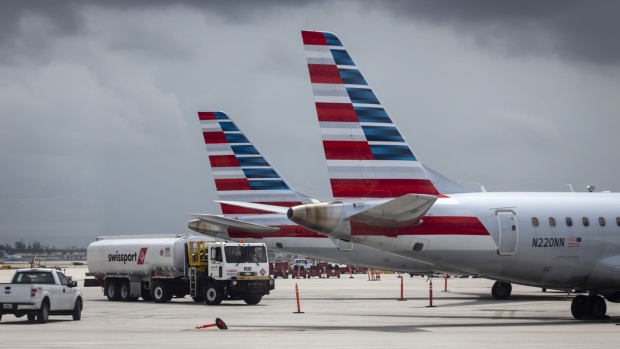Oct 31, 2021
American Airlines’ Canceled Flights Portend Messy Holiday Travel
, Bloomberg News

(Bloomberg) -- The razor-thin staffing that contributed to thousands of canceled U.S. passenger flights in October doesn’t bode well for smooth holiday travel.
American Airlines Group Inc. scrapped about 1,500 flights on Saturday and Sunday, according to tracker FlightAware.com, after operations at its main hub in Dallas were curtained because of winds gusts. Just three weeks ago, Southwest Airlines Co. sparked customer ire when it canceled 3,100 flights over four days because of storms and interrupted air traffic control. The airline said it needed to hire more workers to ward off more disruptions.
Airlines have been caught off guard by the rebound of passengers and the need to staff up enough to serve them. It’s likely to happen to American Airlines again as traffic picks up for the holidays, said Dennis Tajer, an American captain and spokesman for the Allied Pilots Association union.
“We are very concerned about the upcoming holiday travel season,” Tajer said in a telephone interview. “They are setting up all the dominoes. All it’s going to take is the finger tip of Mother Nature to send those tumbling.”
For American, those dominoes were toppled earlier this week, when three out of the five runways at Dallas/Fort Worth International airport -- its home base -- were closed because of high wind. The airline canceled 950 flights as of 5:45 p.m. Sunday -- more than a third of its schedule, according to FlightAware. Southwest, also based in Texas, canceled only about 5% of its Sunday schedule.
Demand’s Rising
Last week saw the highest average daily number of passengers outside of brief holiday-weekend peaks since the start of the pandemic in March 2020, according to Transportation Security Administration data. The average was about 1.8 million daily for the seven days through Saturday, or about 84% of the equivalent week in 2019.
The airline networks are more “brittle” because of staff cuts after the pandemic and lockdowns reduced passenger counts, said Samuel Engel, senior vice president of the aviation group at consultant ICF. He also cited a different mix of traveler -- more tourists and fewer business travelers -- that may not match up with staffing at airports. Miami is getting more flights now than Cleveland, for example, he said. Plus, he said, the weather is also getting more extreme, which increases cancellations.
“The underlying forces are going to be with us for a while,” Engel said. “The airline management will get more and more adept at mitigating the impacts.”
American is hiring pilots, flight attendants and support staff to prepare for more passengers, Chief Operating Officer David Seymour wrote in an October letter to employees. The airline will have almost 1,800 flight attendants returning from leave beginning Monday and will hire 600 more by the end of December. The company is also bringing on 4,000 support workers during the final three months of the year, he wrote.
“We continue to staff up across our entire operation and we will see more of our team returning in the coming months,” Seymour said in the letter.
Labor Shortages
The plan to hire workers is easier said than done, union official Tajer said. American wants to add more than 2,500 pilots but there’s a lack of instructors and flight simulators to do that quickly. Support staff is difficult to find because of a general labor shortage and rising wages for competing jobs, he said.
“We don’t know how in the world they make 2 plus 2 equal 10,” Tajer said.
Airline schedules are complex and interdependent, which means delays can ripple through the system and grow in magnitude as they do. Because federal law restricts how many hours a pilot may work, it means that substitute flight crews will be needed if flights run too late. If backup crews are in short supply -- particularly at the end of a month -- airlines will have no choice but to cancel flights.
©2021 Bloomberg L.P.